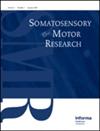根据运动恐惧症水平对老年人步态速度、动态平衡和双重任务平衡表现的比较。
IF 1.1
4区 医学
Q4 NEUROSCIENCES
Somatosensory and Motor Research
Pub Date : 2023-09-01
Epub Date: 2023-01-12
DOI:10.1080/08990220.2023.2165056
引用次数: 1
摘要
目的:发现老年人存在运动恐惧症。研究已经检验了运动恐惧症对患有慢性疼痛的老年人的影响。研究运动恐惧症对没有疼痛的老年人步态和平衡表现的影响是不够的。本研究的目的是根据运动恐惧症水平,比较居住在没有疼痛的社区老年人的步态速度、动态平衡、双重任务平衡表现。材料和方法:包括75名老年人。记录社会人口统计数据(年龄、身高、体重、跌倒史等)。根据坦帕运动恐惧症量表得分,将老年人分为两组。分数低于37分被归类为低水平,分数高于37分被分组为高水平。采用简易精神状态检查(MMSE)、步态速度测试、改良四步四步测试(mFSST)、五次坐立测试、双mFSST测试(附加认知和运动任务)进行双任务平衡表现。结果:36名参与者(平均年龄70.58岁) ± 5.59 年)具有低运动恐惧症,其他39人(平均年龄70.94岁 ± 7.45 年)具有高度运动恐惧症。年龄、性别、体重指数、认知状态和跌倒史在各组之间相似(p > 0.05)。运动恐惧症较低的参与者步态速度、动态平衡、双任务平衡表现较好(p 结论:本研究结果表明,高水平运动恐惧症的存在会影响老年人的步态速度、动态平衡、双任务平衡表现和双任务成本。因此,高度的运动恐惧症会导致跌倒。研究老年人运动恐惧症的影响可能很重要。本文章由计算机程序翻译,如有差异,请以英文原文为准。
Comparison of gait speed, dynamic balance, and dual-task balance performance according to kinesiophobia level in older adults.
Abstract Purpose The presence of kinesiophobia was identified in older adults. Studies have examined the effects of kinesiophobia in older adults with chronic pain. Studies examining the effect of kinesiophobia on gait and balance performance in older adults without pain are insufficient. The aim of this study was to compare gait speed, dynamic balance, dual-task balance performance according to kinesiophobia level in community dwelling older adults without pain. Materials and methods Seventy-five older adults were included. The socio-demographic data (age, height, weight, fall history, etc.) was recorded. Older adults were divided into two groups based on Tampa Kinesiophobia Scale scores. Scores below 37 were grouped as low level, scores above 37 were grouped as high level. The mini-mental state examination (MMSE), gait speed test, modified Four Square Step Test (mFSST), Five Times Sit-to-Stand Test, dual-mFSSt test (additional cognitive and motor task) were applied for dual-task balance performance. Results Thirty-six participants(mean age 70.58 ± 5.59 years) had low kinesiophobia, the other 39 individuals(mean age70.94 ± 7.45 years) had high kinesiophobia. The age, gender, body mass index, cognitive status, and fall history were similar between groups (p > 0.05). The participants with low kinesiophobia were found to have better gait speed, dynamic balance, dual-task balance performance (p < 0.001). Conclusion This study results showed that the presence of high level of kinesiophobia affects gait speed, dynamic balance, dual-task balance performance, and dual-task cost in older adults. Therefore, a high level of kinesiophobia can lead to falls. It may be important to investigate the effects of kinesiophobia in older adults.
求助全文
通过发布文献求助,成功后即可免费获取论文全文。
去求助
来源期刊

Somatosensory and Motor Research
医学-神经科学
自引率
0.00%
发文量
4
审稿时长
>12 weeks
期刊介绍:
Somatosensory & Motor Research publishes original, high-quality papers that encompass the entire range of investigations related to the neural bases for somatic sensation, somatic motor function, somatic motor integration, and modeling thereof. Comprising anatomical, physiological, biochemical, pharmacological, behavioural, and psychophysical studies, Somatosensory & Motor Research covers all facets of the peripheral and central processes underlying cutaneous sensation, and includes studies relating to afferent and efferent mechanisms of deep structures (e.g., viscera, muscle). Studies of motor systems at all levels of the neuraxis are covered, but reports restricted to non-neural aspects of muscle generally would belong in other journals.
 求助内容:
求助内容: 应助结果提醒方式:
应助结果提醒方式:


